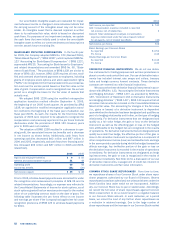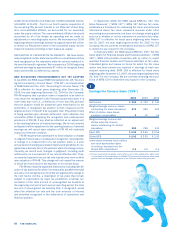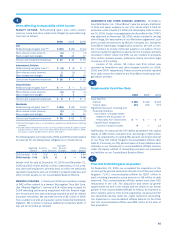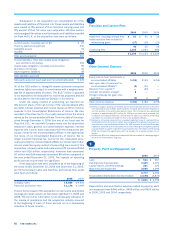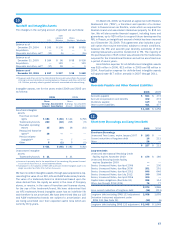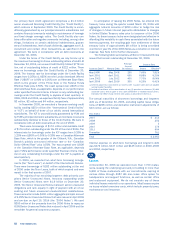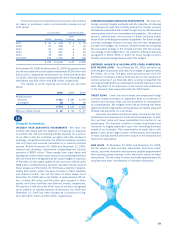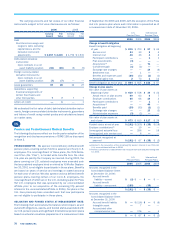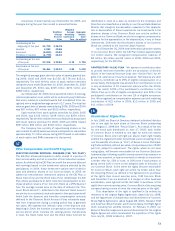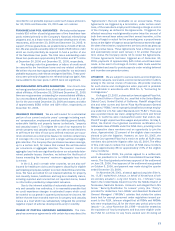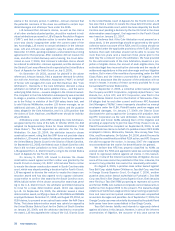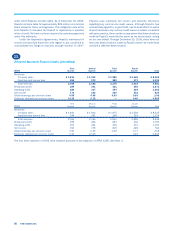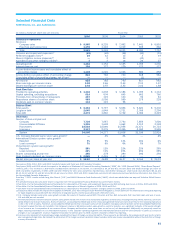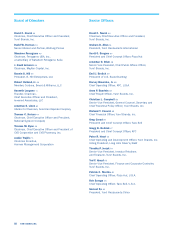Pizza Hut 2006 Annual Report Download - page 67
Download and view the complete annual report
Please find page 67 of the 2006 Pizza Hut annual report below. You can navigate through the pages in the report by either clicking on the pages listed below, or by using the keyword search tool below to find specific information within the annual report.
72 YUM! BRANDS, INC.
BENEFIT PAYMENTS The benefits expected to be paid in each
of the next five years and in the aggregate for the five years
thereafter are set forth below:
U.S. International
Year ended: Pension Plans Pension Plans
2007 $ 22 $ 2
2008 25 2
2009 29 2
2010 32 2
2011 39 2
2012 – 2016 279 10
Expected benefits are estimated based on the same assump-
tions used to measure our benefit obligation on the measurement
date and include benefits attributable to estimated further
employee service.
POSTRETIREMENT MEDICAL BENEFITS Our postretirement
plan provides health care benefits, principally to U.S. salaried
retirees and their dependents, and includes retiree cost sharing
provisions. During 2001, the plan was amended such that any
salaried employee hired or rehired by YUM after September 30,
2001 is not eligible to participate in this plan. Employees hired
prior to September 30, 2001 are eligible for benefits if they meet
age and service requirements and qualify for retirement benefits.
We fund our postretirement plan as benefits are paid.
At the end of 2006 and 2005, the accumulated postretire-
ment benefit obligation is $68 million and $69 million, respectively.
The unrecognized actuarial loss recognized in Accumulated other
comprehensive loss is $4 million at the end of 2006. The net
periodic benefit cost recorded in 2006, 2005, and 2004 was
$6 million, $8 million and $8 million, respectively, the major-
ity of which is interest cost on the accumulated postretirement
benefit obligation. The weighted-average assumptions used to
determine benefit obligations and net periodic benefit cost for
the postretirement medical plan are identical to those as shown
for the U.S. pension plans. Our assumed heath care cost trend
rates for the following year as of 2006 and 2005 are 9.0% and
10.0%, respectively, both with an expected ultimate trend rate of
5.5% reached in 2012.
There is a cap on our medical liability for certain retirees. The
cap for Medicare eligible retirees was reached in 2000 and the
cap for non-Medicare eligible retirees is expected to be reached
in 2010; once the cap is reached, our annual cost per retiree
will not increase. A one-percentage-point increase or decrease
in assumed health care cost trend rates would have less than a
$1 million impact on total service and interest cost and on the
post retirement benefit obligation. The benefits expected to be
paid in each of the next five years are approximately $5 million
and in aggregate for the five years thereafter are $28 million.
16.
Stock Options and Stock Appreciation Rights
At year-end 2006, we had four stock award plans in effect: the
YUM! Brands, Inc. Long-Term Incentive Plan (“1999 LTIP”), the
1997 Long-Term Incentive Plan (“1997 LTIP”), the YUM! Brands,
Inc. Restaurant General Manager Stock Option Plan (“RGM Plan”)
and the YUM! Brands, Inc. SharePower Plan (“SharePower”).
Under all our plans, the exercise price of stock options and stock
appreciation rights (“SARs”) granted must be equal to or greater
than the average market price of the Company’s stock on the
date grant.
We may grant awards of up to 29.8 million shares and
45.0 million shares of stock under the 1999 LTIP, as amended,
and 1997 LTIP, respectively. Potential awards to employees and
non-employee directors under the 1999 LTIP include stock options,
incentive stock options, SARs, restricted stock, stock units,
restricted stock units, performance shares and performance units.
Potential awards to employees and non-employee directors under
the 1997 LTIP include restricted stock and performance restricted
stock units. Prior to January 1, 2002, we also could grant stock
options, incentive stock options and SARs under the 1997 LTIP.
Through December 30, 2006, we have issued only stock options
and performance restricted stock units under the 1997 LTIP and
have issued only stock options and SARs under the 1999 LTIP.
While awards under the 1999 LTIP can have varying vesting provi-
sions and exercise periods, previously granted awards under the
1997 LTIP and 1999 LTIP vest in periods ranging from immediate
to 2010 and expire ten to fifteen years after grant.
We may grant awards to purchase up to 15.0 million shares
of stock under the RGM Plan. Potential awards to employees under
the RGM Plan include stock options and SARs. RGM Plan awards
granted have a four year vesting period and expire ten years after
grant. Certain RGM Plan awards are granted upon attainment of
performance conditions in the previous year. Expense for such
awards is recognized over a period that includes the performance
condition period.
We may grant awards to purchase up to 14.0 million shares
of stock under SharePower. Potential awards to employees under
SharePower include stock options, SARs, restricted stock and
restricted stock units. SharePower awards granted subsequent
to the Spin-off Date consist only of stock options and SARs to
date, which vest over a period ranging from one to four years and
expire no longer than ten years after grant. Previously granted
SharePower awards have expirations through 2016.
We estimated the fair value of each award made during
2006, 2005 and 2004 as of the date of grant using the Black-
Scholes option-pricing model with the following weighted-average
assumptions:
2006 2005 2004
Risk-free interest rate 4.5% 3.8% 3.2%
Expected term (years) 6.0 6.0 6.0
Expected volatility 31.0% 36.6% 40.0%
Expected dividend yield 1.0% 0.9% 0.1%
In connection with our adoption of SFAS 123R in 2005, we
determined that it was appropriate to group our awards into two
homogeneous groups when estimating expected term. These
groups consist of grants made primarily to restaurant-level
employees under the RGM Plan, which typically cliff vest after
four years, and grants made to executives under our other stock
award plans, which typically have a graded vesting schedule and
vest 25% per year over four years. We use a single-weighted
average expected term for our awards that have a graded vesting
schedule as permitted by SFAS 123R. Based on analysis of our
historical exercise and post-vesting termination behavior we have
determined that six years is an appropriate term for both awards
to our restaurant-level employees and awards to our executives.
Prior to the adoption of SFAS 123R in 2005 we have tradition-
ally based expected volatility on Company specific historical stock
data over the expected term of the option. Subsequent to adop-
tion, we revaluated expected volatility, including consideration of
both historical volatility of our stock as well as implied volatility
associated with our traded options.


